5. March 2014 von Eric Schmidtchen
The Department of Classics at Humboldt-Universität Berlin is holding an International Conference on Medical Translators at Work. Syriac, Arabic, Hebrew and Latin Translations in Dialogue
International Conference, 20-21 March 2014, Humboldt-Universität zu Berlin.
The workshop is free to attend, but registration is required by March 16, 2014
More …
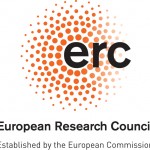 The BabMed Project has received funding from the European Research Council under the European Union’s Seventh Framework Programme (FP7/2007-2013) / ERC Grant agreement no. 323596.
The BabMed Project has received funding from the European Research Council under the European Union’s Seventh Framework Programme (FP7/2007-2013) / ERC Grant agreement no. 323596.
Kategorie Allgemein | Comments Off on Int. Conference: Medical Translators at Work
28. February 2014 von Eric Schmidtchen
Shamma Friedman, Project Advisor und Leiter des BabMed-Partnerprojektes an der Bar-Ilan-Universität wird 2014 den siebten Israel-Preis in Talmud Studien erhalten. Der Israel-Preis ist die höchste Auszeichnung des Staates Israel und wird am 5. Mai 2014, dem Israelischen Unabhängigkeitstag Yom Ha’atzmaut verliehen. Mehr unter …
Professor Friedman, ein Schüler des bekannten Professors Saul Lieberman, erhält den Preis für sein Lebenswerk im Bereich der Erforschung der rabbinischen Literatur, die von Studien zu frührabbinischen Texten (Mischna/Tosefta), rabbinischem Hebräisch und narrativen Traditionen im rabbinischen Corpus reichen. Sein unschätzbarer wissenschaftlicher Beitrag liegt jedoch insbesondere in seinen bahnbrechenden Erkenntnissen zur literarischen und kompositionellen Struktur des Babylonischen Talmuds.
Dabei entwickelte Friedman eine Methode, um die verschiedenen redaktionellen Schichten (frührabbinisch-tannaitisch/amoräisch/anonym) dieses Textes und ihre komplexen Verbindungen und Interaktionen zu analysieren. Dieser Zugang kombiniert die historische Handschriftenkunde mit philologischer Quellenkritik und literarischen Analysen.
Im Zuge seiner Studien zum Bavli (Babylonischer Talmud) wurde Friedman auch zum Pionier im Bereich der Digitalisierung und Katalogisierung von rabbinischen Quellentexten. Dank dieser Anstrengungen sind heute nicht nur viele Handschriftenvarianten und Fragmente des Talmuds für die Forschung zugänglich (Lieberman Institute), sondern auch die Textzeugen der frührabbinischen Literatur (Tannaim) sowie ein Index für relevante Primär- und Sekundärtexte (Lieberman-Index).
Shamma Friedman ist Professor für Talmud und rabbinische Literatur an der Bar Ilan Universität (Ramat Gan, Israel) und am Jewish Theological Seminary (JTS, New York) sowie Dozent am Schechter Institut (Jerusalem). Eine Vielzahl von Professor Friedmans Artikeln lässt sich hier finden. Vor etwa 20 Jahren gründete Shamma Friedman eine akademische Vereinigung, deren Publikationen sich vor allem der kritischen Kommentierung des Babylonischen Talmuds widmen (Link). Außerdem ist er erster Herausgeber einer neuen wissenschaftlichen Zeitschrift für Talmudstudien (Oqimta).
Lennart Lehmhaus
Wiss. Mitarbeiter (PostDoc), Projekt A03 “Talmudische Medizin”
SFB 980 “Episteme in Bewegung“, Freie Universität Berlin
 The BabMed Project has received funding from the European Research Council under the European Union’s Seventh Framework Programme (FP7/2007-2013) / ERC Grant agreement no. 323596.
The BabMed Project has received funding from the European Research Council under the European Union’s Seventh Framework Programme (FP7/2007-2013) / ERC Grant agreement no. 323596.
Kategorie Allgemein | Comments Off on Israel-Preis an Prof. S. Friedman, BabMed Partner-Universität
15. February 2014 von John Schlesinger

© Der Tagesspiegel
Die Wissenschaftseite des Berliner Tagesspiegels veröffentlichte zu Jahresbeginn ein ausführliches Portrait über Mark Geller und seine Arbeit in Berlin: Im Fokus steht hier natürlich auch das über den Europäischen Wissenschaftsrat finanzierte BabMed-Projekt. Zum Tagesspiegel-Artikel
Agnes Kloocke

The BabMed Project has received funding from the European Research Council under the European Union’s Seventh Framework Programme (FP7/2007-2013) / ERC Grant agreement no. 323596.
Kategorie Allgemein | Comments Off on Principal Investigator Mark Geller
10. February 2014 von Eric Schmidtchen
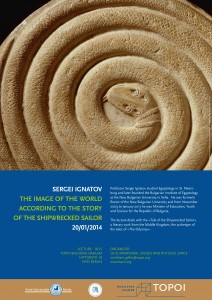
Design: B. Nennstiel, TOPOI, 2013
Foto: Rijksmuseum van Oudheden, Leiden
Professor Sergei Ignatov studied Egyptology in St. Petersburg and later founded the Bulgarian Institute of Egyptology at the New Bulgarian University in Sofia. He was formerly Rector of the New Bulgarian University and from November 2009 to January 2013 he was Minister of Education, Youth and Science for the Republic of Bulgaria. The lecture deals with the «Tale of the Shipwrecked Sailor», a literary work from the Middle Kingdom, the archetype of the tales of «The Odyssey». As an introduction to his lecture S. Ignatov dealt with a short story of the Russian School of Egyptology. The lecture itself offered new insights in the story of the «Shipwrecked Sailor» – the main research topic of the speaker for many years – and the personal view of Sergei Ignatov on the Egyptian world.
Strahil V. Panayotov

The BabMed Project has received funding from the European Research Council under the European Union’s Seventh Framework Programme (FP7/2007-2013) / ERC Grant agreement no. 323596.
Kategorie Allgemein | Comments Off on Sergei Ignatov reads on «Odyssey» from Ancient Egypt
7. January 2014 von Marius Hoppe
John Steele von der Brown University in Providence, Rhode Island war am 9.12.2013 mit einem Seminar bei BabMed zu Gast. Der Spezialist für die Geschichte der Astronomie diskutierte mit dem Projekt-Team die Verbindungen zwischen dem Forschungsgebiet der babylonischen Astronomie und der babylonischen Medizin.
Link zu John Steele an der Brown University, Rhode Island.
Marius Hoppe

The BabMed Project has received funding from the European Research Council under the European Union’s Seventh Framework Programme (FP7/2007-2013) / ERC Grant agreement no. 323596.
Kategorie Allgemein | Comments Off on John Steele in Berlin
12. December 2013 von John Schlesinger
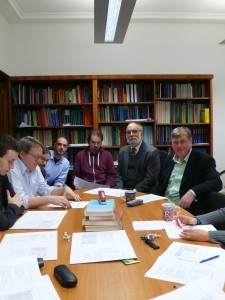
Alexander Jones in Berlin
Photo: F. Badalanova Geller, 2013
Alexander Jones, Professor für Antike Wissenschaftsgeschichte am Institute for the Study of the Ancient World der New York University, hielt am 2.12.2013 ein Gastseminar, welches bemerkenswerte Verbindungen zwischen den mesopotamischen Mondphasenberechnungen und einigen Konstanten in der griechisch-römischen Astrologie aufzeigte.
Eric Schmidtchen

The BabMed Project has received funding from the European Research Council under the European Union’s Seventh Framework Programme (FP7/2007-2013) / ERC Grant agreement no. 323596.
Kategorie Allgemein | Comments Off on Gastseminar Alexander Jones
15. November 2013 von Janika Urig
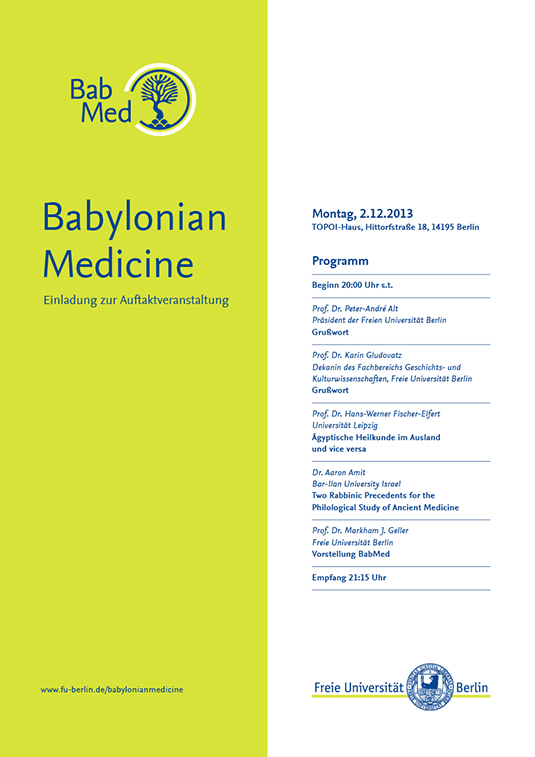
Poster

The BabMed Project has received funding from the European Research Council under the European Union’s Seventh Framework Programme (FP7/2007-2013) / ERC Grant agreement no. 323596.
Kategorie Allgemein | Comments Off on BabMed Launch am 2.12.2013
11. November 2013 von Natanael Anor

Sir Geoffrey Lloyd and PI Mark Geller Photo by Gerd Schubert, 2013
Undertaking a project such as “Babylonian Medicine” is by no means a simple task. It compels us to deal with the complex questions that the ancient medical texts raise, such as to what extent these texts deal with magic or medicine or whether we should simply refer to healing practices? Is a given ancient term the name of a disease or is it describing a symptom? Since today’s local flora and inventory of diseases are not entirely reliable as a cross-cultural schema, how are we to deal with the ancient names of diseases, medicinal plants or other materia medica? One way is to translate ancient terms into modern languages and thus risk misleading present-day readers. The alternative is to leave technical terms untranslated, thereby making ancient practices more obscure. Common to all these questions is that they rarely have straightforward answers; they mainly evoke discussions.
Those very discussions, however, require expertise in various disciplines and approaches. For this reason, it was particularly significant that the fourth “Dahlem Seminar for the History of Science” began with a visit from one of the leading experts on ancient medicine, Sir Geoffrey Lloyd. His multi-perspective point of view was of immense importance for this BabMed inaugural event. His inspiring talk stressed the roles of anthropological models in understanding ancient medicine. First, we heard in his lecture about the significance of analogisms and analogical systems in the practice and theory of ancient healing. Lloyd also emphasized the implications of the dichotomy between interiority and physicality when trying to analyse ancient systems of thought.
Lloyd suggested that one of the major reasons why we encounter difficulties with this type of cross-cultural comparison is that we tend to think there is one universal mechanism called “nature” and that each human culture has a specific approach to it. But “culture” is actually the one phenomenon that is universal and common to all human societies and that, in order to communicate and thus prosper, each culture has invented its own apparatus to understand its environment. Therefore, the many different perceptions of “nature” can be found around the globe.
Later on, a group of doctoral students also had the chance to participate in an informal meeting with our honoured guest. This meeting turned out to be very fruitful for all the participants as each member of the group got the chance to present his or her own project and field of interest. In return, Sir Geoffrey was happy to share his insights on how to approach some of the problems presented and also pointed out interesting parallel phenomena from other cultures. Overall, the visit was very productive precisely because it provided the group with the kind of broadly formulated comparative point of view that we need in order to make sense of ancient medicine.
Netanel Anor

The BabMed Project has received funding from the European Research Council under the European Union’s Seventh Framework Programme (FP7/2007-2013) / ERC Grant agreement no. 323596.
Kategorie Allgemein | Comments Off on Sir Geoffrey Lloyd’s Visit
4. November 2013 von Janika Urig
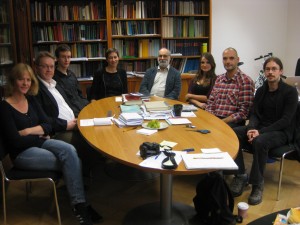
From left to right: T. Hidde, C. Johnson, M. Hoppe, U. Steinert, M. Geller, M. Lorenz, S. Panayotov, E. Schmidtchen Photo by: F. Badalanova Geller, 2013
BabMed represents the first ever comprehensive study of ancient Babylonian medical science since the decipherment of cuneiform, comprising the largest ancient collection of medical data before Hippocrates. The latest phase of Babylonian medicine, as preserved in Aramaic in the Babylonian Talmud, has never been systematically studied in the light of older cuneiform materials. The absence of accessible cuneiform medical literature has forced recent medical histories to bypass Babylonian medicine, while Aramaic medicine in the Babylonian Talmud has largely been ignored. BabMed tests a number of ‘high risk’ propositions, including two key hypotheses:
1) cuneiform survived much longer than previously suspected, and
2) Aramaic medicine in the Babylonian Talmud mostly derives from Akkadian medicine.
BabMed will introduce a new paradigm for knowledge transfer which will recognise the barriers between ancient arts of medicine and how they were overcome in antiquity. One such barrier was script and language.
 The BabMed Project has received funding from the European Research Council under the European Union’s Seventh Framework Programme (FP7/2007-2013) / ERC Grant agreement no. 323596.
The BabMed Project has received funding from the European Research Council under the European Union’s Seventh Framework Programme (FP7/2007-2013) / ERC Grant agreement no. 323596.
Kategorie Allgemein | 0 Kommentare »
 The BabMed Project has received funding from the European Research Council under the European Union’s Seventh Framework Programme (FP7/2007-2013) / ERC Grant agreement no. 323596.
The BabMed Project has received funding from the European Research Council under the European Union’s Seventh Framework Programme (FP7/2007-2013) / ERC Grant agreement no. 323596.







 Die
Die